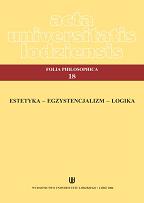Tekstualizm i alegoria przeciw modernistycznym koncepcjom bezpośredniej komunikacji
Textuality and Allegory Against Modern Concepts of Immediacy of Meaning
Author(s): Agnieszka Rejniak-MajewskaSubject(s): Philosophy
Published by: Wydawnictwo Uniwersytetu Łódzkiego
Keywords: aesthetics; textuality; allegory; modernism; immediacy of meaning
Summary/Abstract: The article discusses the theoretical background of some postmodern art practices of appropriation. In the writings of art critics' like Douglas Crimp, Craig Owens, or Rosalind Krauss, as well as in some artists' statements (Peter Halley, Sherrie Levine), there was a strong repudiation of the so-called "modern" concepts of originality, immediacy of meaning or authorship. As a result of the influence of poststructuralist theories, such concepts of modern art as the idea of original expressivity of medium and form, together with the search to go beyond conventional codes, were replaced by ideas of intertextuality, iterability, there is no way to go beyond conventional codes of communication resulted in turning towards another strategy, i.c. a play with the code. In the works of some theoretically informed postmodern artists' this criticism towards the "utopian" ideas of modern art assumed the form of pastiche and appropriation of celebrated works of modern art, so that the fact of cultural mediation in our reading of artworks was comming well apparent. The modern concept of "pure visuality" was replaced by textual attitudes and the concept of allegory which was drawn from Walter Benjamin. However, thinking about visual works in terms of textuality only may be a too narrow view. Textual categories seem to suit well those works which came under the strong influence of conventionalist theories, but it may be claimed that images put a demand for a more complex and specific theoretical attitude, like for example one proposed by Barthes in his text "The Third Meaning".
Journal: Acta Universitatis Lodziensis. Folia Philosophica. Ethica - Aesthetica - Practica
- Issue Year: 2006
- Issue No: 18
- Page Range: 19-38
- Page Count: 20
- Language: Polish

